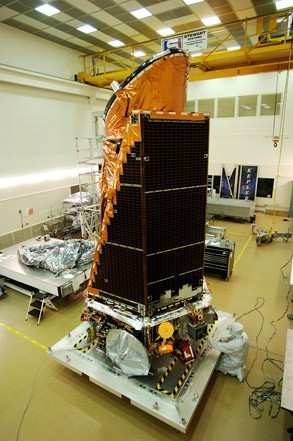Agency Continues To Find New Planets And 'Planet Objects', But
None In This Group In The Habitable Zone
NASA says its Kepler mission has discovered 11 new planetary
systems hosting 26 confirmed planets. These discoveries nearly
double the number of verified planets and triple the number of
stars known to have more than one planet that transits, or passes
in front of, the star. Such systems will help astronomers better
understand how planets form.
Kepler Probe Pre-Launch

The planets orbit close to their host stars and range in size
from 1.5 times the radius of Earth to larger than Jupiter. Fifteen
are between Earth and Neptune in size. Further observations will be
required to determine which are rocky like Earth and which have
thick gaseous atmospheres like Neptune. The planets orbit their
host star once every six to 143 days. All are closer to their host
star than Venus is to our sun.
"Prior to the Kepler mission, we knew of perhaps 500 exoplanets
across the whole sky," said Doug Hudgins, Kepler program scientist
at NASA Headquarters in Washington. "Now, in just two years staring
at a patch of sky not much bigger than your fist, Kepler has
discovered more than 60 planets and more than 2,300 planet
candidates. This tells us that our galaxy is positively loaded with
planets of all sizes and orbits."
Kepler identifies planet candidates by repeatedly measuring the
change in brightness of more than 150,000 stars to detect when a
planet passes in front of the star. That passage casts a small
shadow toward Earth and the Kepler spacecraft. Each of the new
confirmed planetary systems contains two to five closely spaced
transiting planets. In tightly packed planetary systems, the
gravitational pull of the planets on each other causes some planets
to accelerate and some to decelerate along their orbits. The
acceleration causes the orbital period of each planet to change.
Kepler detects this effect by measuring the changes, or so-called
Transit Timing Variations (TTVs). Planetary systems with TTVs can
be verified without requiring extensive ground-based observations,
accelerating confirmation of planet candidates. The TTV detection
technique also increases Kepler's ability to confirm planetary
systems around fainter and more distant stars.

Five of the systems (Kepler-25, Kepler-27, Kepler-30, Kepler-31
and Kepler-33) contain a pair of planets where the inner planet
orbits the star twice during each orbit of the outer planet. Four
of the systems (Kepler-23, Kepler-24, Kepler-28 and Kepler-32)
contain a pairing where the outer planet circles the star twice for
every three times the inner planet orbits its star. "These
configurations help to amplify the gravitational interactions
between the planets, similar to how my sons kick their legs on a
swing at the right time to go higher," said Jason Steffen, the
Brinson postdoctoral fellow at Fermilab Center for Particle
Astrophysics in Batavia, IL, and lead author of a paper confirming
four of the systems. Kepler-33, a star that is older and more
massive than our sun, had the most planets. The system hosts five
planets, ranging in size from 1.5 to 5 times that of Earth. All of
the planets are located closer to their star than any planet is to
our sun.
The properties of a star provide clues for planet detection. The
decrease in the star's brightness and duration of a planet transit,
combined with the properties of its host star, present a
recognizable signature. When astronomers detect planet candidates
that exhibit similar signatures around the same star, the
likelihood of any of these planet candidates being a false positive
is very low. "The approach used to verify the Kepler-33 planets
shows the overall reliability is quite high," said Jack Lissauer,
planetary scientist at NASA Ames Research Center at Moffett Field,
CA, and lead author of the paper on Kepler-33. "This is a
validation by multiplicity."
These discoveries are published in four different papers in the
Astrophysical Journal and the Monthly Notices of the Royal
Astronomical Society.
 ANN's Daily Aero-Linx (04.13.24)
ANN's Daily Aero-Linx (04.13.24) ANN's Daily Aero-Term (04.13.24): Beyond Visual Line Of Sight (BVLOS)
ANN's Daily Aero-Term (04.13.24): Beyond Visual Line Of Sight (BVLOS) Airborne 04.09.24: SnF24!, Piper-DeltaHawk!, Fisher Update, Junkers
Airborne 04.09.24: SnF24!, Piper-DeltaHawk!, Fisher Update, Junkers Aero-News: Quote of the Day (04.14.24)
Aero-News: Quote of the Day (04.14.24) ANN's Daily Aero-Term (04.14.24): Maximum Authorized Altitude
ANN's Daily Aero-Term (04.14.24): Maximum Authorized Altitude




